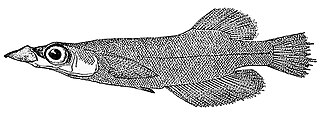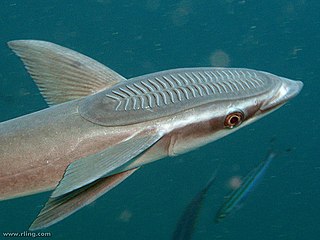Dellichthys is a small genus of clingfishes from the family Gobiesocidae which are endemic to New Zealand. It had been regarded as a monotypic genus but a second species was described in 2018.
The giant clingfish, Haplocylix littoreus, is a clingfish of the family Gobiesocidae, the only species in the genus Haplocylix. It is found all down the east coast of New Zealand around the low water mark amongst seaweed, on rocky coastlines. Its length is up to 15 centimetres (5.9 in). This species was originally described as Cyclopterus littoreus in 1801 by Johann Reinhold Forster, John C. Briggs subsequently placed it in the monotypic genus Haplocylix. Its closest relative appears to be the Caribbean deepwater clingfish Gymnoscyphus ascitus.

Adrianichthys kruyti is a critically endangered species of ricefish that is endemic to Lake Poso, Sulawesi, Indonesia. It was discovered by Max Wilhelm Carl Weber on his Siboga Expedition to Indonesia.
Cairnsichthys is a genus of rainbowfishes from the subfamily Melanotaeniinae. The genus is endemic to freshwater streams in eastern Queensland in north eastern Australia. The genus was designated as a monotypic genus in 1928 by John T. Nichols and Henry C. Raven but in 2018 a second species was assigned to the genus.

Oryzias is a genus of ricefishes native to fresh and brackish water in east and south Asia. Some species are widespread and the Japanese rice fish is commonly used in science as a model organism, while others have very small ranges and are threatened. They are small, up to 8 cm (3.1 in) long, and most are relatively plain in colour.
Phallostethus dunckeri is a species of fish in the family Phallostethidae. It is endemic to Malaysia.
Telmatherina antoniae is a species of fish in the subfamily Telmatherininae part of the family Melanotaeniidae, the rainbowfishes. It is endemic to Indonesia where it occurs only in Lake Matano on Sulawesi. The species was described in 1991 by Maurice Kottelat and its specific name honours his wife, Antonia.
Telmatherina sarasinorum is a species of fish in the subfamily Telmatherininae part of the family Melanotaeniidae, the rainbowfishes. It is endemic to Indonesia, where it occurs only in Lake Matano on the island of Sulawesi. This species was described in 1991 by Maurice Kottelat, the types being collected at Mengonuwai on Lake Matano. Kottelat gave the species the specific name sarasinorum in honour of the Swiss second cousins, naturalists and ethnographers Paul (1856-1929) and Fritz Sarasin (1859-1942). The Sarasins discovered Lake Matano and collected the first specimens of fishes in the genus Telmatherina.
Telmatherina wahjui is a species of fish in the subfamily Telmatherininae part of the family Melanotaeniidae, the rainbowfishes. It is endemic to Indonesia, where it occurs only in Lake Matano on the island of Sulawesi. It can reach a maximum length of around 5 centimetres (2.0 in). This species was described in 1991 by Mairice Kottelat with a type locality of Alaponkepi which is situated at the outlet of Lake Matano. The specific name honours Beni N. Wahju who was Vice President and Secretary of P. T. Inco Industries, Mr Wahju's support was vital in ensuring the ichthyological survey of the Malili Lakes, on which the type of this species was collected, was possible.
Popta's buntingi is a critically endangered species of fish in the family Adrianichthyidae. It is endemic to Lake Poso in Sulawesi, Indonesia. This species was described by Max Carl Wilhelm Weber and Lieven Ferdinand de Beaufort in 1922 and they gave it the species name poptae in honour of their fellow Dutch ichthyologist Canna Maria Louise Popta (1860-1929).

Oryzias sarasinorum, the Sarasins minnow or Sarasins buntingi, is a species of ricefish in the Adrianichthyidae. It is endemic to Lake Lindu in Lore Lindu National Park, Sulawesi, Indonesia. This species was described as Haplochilus sarasinorum by C.M.L. Popta in 1905 and she named it in honour of the Swiss naturalists and second cousins Paul Sarasin (1856-1929) and Fritz Sarasin (1859-1942), the latter being the collector of the type. Although the IUCN state that the population of this fish is stabled it is threatened by introduced non native fish, common carp, Mozambique tilapia and walking catfish; and a decline in water quality caused by increased agriculture in the lake's catchment which is causing a decline in water quality, it is therefore assessed as Critically Endangered.

Echeneis is a genus of fish in the family Echeneidae, the remoras. The genus is distributed in the Atlantic, Pacific and Indian Oceans.

Austrolebias bellottii, the Argentine pearlfish, is a species of killifish from the family Rivulidae which occurs in the basins of the Paraná River and Uruguay River, in Argentina and Uruguay. This species was described as Cynolebias bellottii by the Austrian ichthyologistFranz Steindachner in 1881 from types collected at La Plata, Argentina. The specific name honours the Italian biologist and paleontologist Cristoforo Bellotti (1823-1919), who supplied Steindachner with specimens from his collection at Museo Civico di Storia Naturale di Milano. It is the type species of the genus Austrolebias.
Enneapterygius ziegleri, known commonly as the Ziegler's triplefin, is a species of triplefin blenny in the genus Enneapterygius. It was described by Ronald Fricke in 1994. Its specific name honours Bernhard Ziegler (1929-2013), a paleontologist and Director of the State Museum of Natural History in Stuttgart, Germany. This species occurs in the Timor Sea of Indonesia and East Timor and in the Philippines.
Helcogramma ellioti, known commonly as the red-eye threefin, is a species of triplefin blenny in the genus Helcogramma. It was described by Albert William Herre in 1944 who honoured the Scottish naturalist and ethnologist Walter Elliot (1803-1897) in its specific name. This species occurs in the Indian Ocean along the eastern and western coasts of India and around Sri Lanka.
Pelangia mbutaensis is a species of rainbowfish endemic to West Papua in Indonesia. This species was described by Gerald R. Allen in 1988 from types collected from the Lake Mbuta Basin which lies about 8 kilometers northwest of Etna Bay in West Papua. It is the only known member of its genus, the name Pelangia is derived from the Indonesian word for "rainbow" and the specific name refers to the type locality, the swampy basin of Lake Mbuta.

Fodiator is a genus of flying fishes. It is the only genus in the subfamily Fodiatorinae.
The panatela silverside is a species of reef-dwelling silverside from the subfamily Atherinomorinae which is found in the southwest Pacific Ocean. This species grows to 11 cm (4.3 in) in total length and is of minor importance to commercial fisheries. This species is the only species in the genus Stenatherina, although some authorities place it in the genus Hypoatherina. This species was described by David Starr Jordan and Robert Earl Richardson as Atherina panatela with the type locality given as Calayan Island in the Philippines. The specific name is the Spanish word for a long, thin cigar and is presumed to be a reference to the elongated, slender body of this fish.
Adrianichthys roseni is a species of ricefish, a member of the family Adrianichthyidae which is endemic to Lake Poso on Sulawesi. Since the holotype was collected in 1978 there have been no reports of this species and if it still exists then it has a very low population. The IUCN categorise it as Critically Endangered. The specific name honours Donn Eric Rosen (1929-1986) of the American Museum of Natural History.

The licorice gourami is a species of freshwater ray-finned fish from the subfamily Macropodusinae, part of the family Osphronemidae, the gouramis. It is endemic to Bangka in Indonesia where it is found in the slow, flowing streams with black waters associated with peat swamp forests. This species was formally described by the Dutch ichthyologist Pieter Bleeker as Osphromenus deissneri in 1859 with the type locality given as Sungai Baturussa basin at 8 kilometres from Pudingbesar on the road to Kampong Simpan, Bangka. It is the type species of the genus Parosphromenus. The specific name honours F. H. Deissner, a military health officer, who sent a collection of specimens of fishes from Bangka to Bleeker which included the type of this species.







